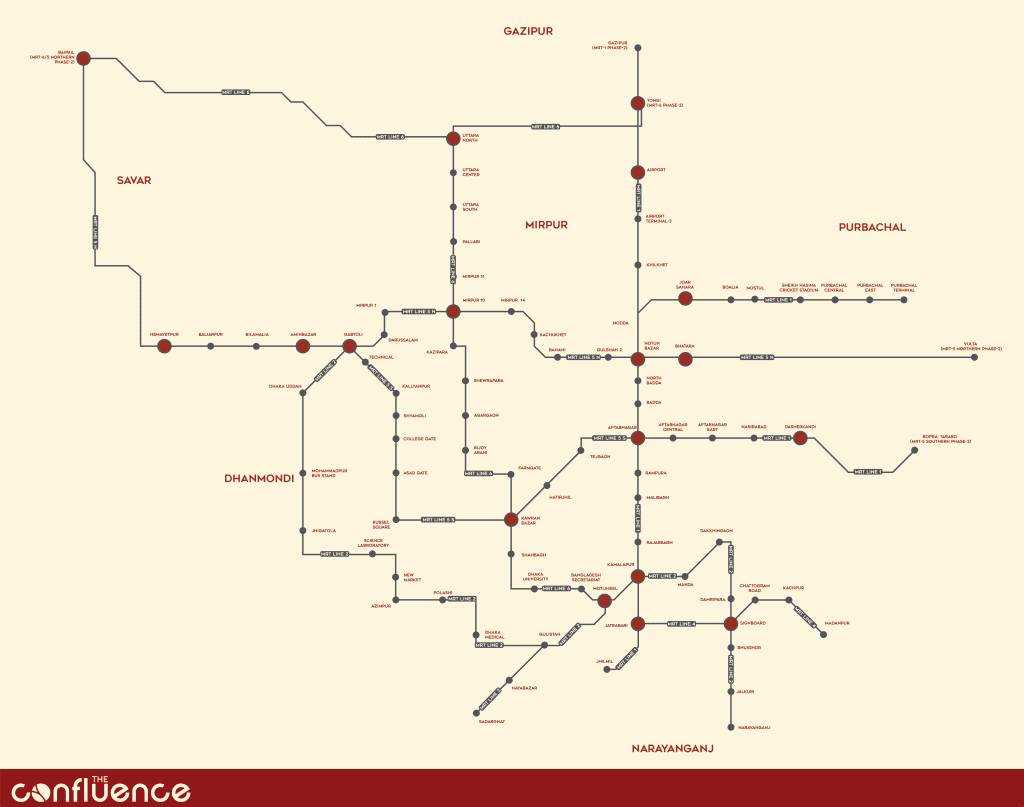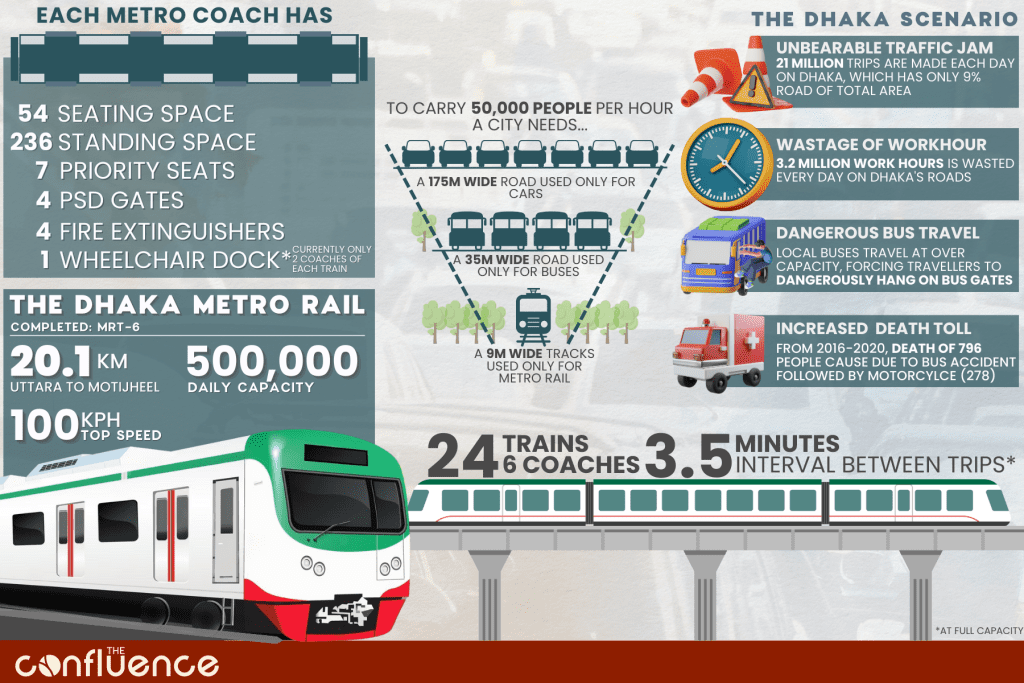Dhaka, a metropolis with a four-century history, stands as a testament to history’s layers. However, a story of chaotic growth has been weaved into its numerous streets and avenues due to a lack of urban planning.
The end result was congested roadways and an average city speed as shockingly low as 4.5 kmph. Traffic jams waste 3.2 million work hours every day, forcing locals to add an additional 2 to 3 hours to their commutes. In the middle of Dhaka’s traffic maze, the city saw its first good samaritan with the inauguration of the Dhaka Metro Rail.
Delving into Dhaka’s traffic congestion crisis
With a population of 22.3 million within its boundaries, Dhaka has a staggering population density of 23,234 people per square kilometer. So, inevitably, a total of 1.78 million vehicles set out for their destination. According to Dhaka Structure Plan 2016–35, Chapter 5, for a city with only 9% road area, handling 21 million trips on an average working day becomes impossible. Additionally, this plan demonstrates that rickshaws come first in terms of blocking or slowing down Dhaka’s transportation options, followed by local buses.
% of Vehicles Slowing Down Speed
Source: Dhaka Structure Plan 2016-35
No Data Found
Despite being the most affordable medium of transport, local buses most of the time carry passengers way beyond their capacity. Sometimes the number becomes double or even triple the available seating space. It is a very common scenario in Dhaka for passengers to hang almost out of the gates with just one handle to grip. These buses are often responsible for unwanted traffic congestion and accidents as they push brakes in the wrong lane to pick up or drop off passengers. These sudden brakes often leave no room for the vehicles behind to adjust speed, leading to collisions and congestion. These local buses are often unfit for the road, and some of them have no indicator lights or proper suspension systems. Research that analyzed data from 2016 to 2020 shows that local and intercity buses have the highest number of deaths in Dhaka.
Number of Deaths from 2016-20 in Road Accidents by Type of Vehicle
Source: Yu, Jianxin & Rabbi, Fazle & Bin Siraj, Md Sifat & Zhenzhen, Li. (2021). Road Traffic Accident Situation in Dhaka City, Bangladesh. 6. 12.
No Data Found
Moreover, ongoing construction work on roads pushes it even further. Not only are vehicles stuck during heavy construction work, but they also have to face countless potholes. This also makes the journey not only lengthy but also very uncomfortable.
The Metro Rail’s Role in Congestion Mitigation
The Dhaka Metro Rail under the Mass Rapid Transit Project (MRT) is aimed at becoming a very efficient substitute for local buses and private cars for traveling inside the city; it dodges the biggest problem in Dhaka. As the Metro Rail runs on a separate viaduct up above the ground, there’s no question of road traffic or rail crossings. Separate tracks for up and down trips make the journey seamless and efficient.
A straightforward mathematical calculation can explain how the metro rail helps reduce traffic congestion in Dhaka. The MRT Line 6, which is the first to start operation among the six planned lines across Dhaka, has a total of 24 trains. Every train has six coaches, each with a capacity to carry 290 passengers. Thus, one trip can seamlessly carry 1740 passengers, which is the equivalent of 22 jam-packed local buses. If we assume 5% of these passengers have a private car, the number of private cars turns out to be 87.
This is just for one trip. At full functional capacity, the MRT-6 is built to provide more than 600 trips a day. This theoretically omits 65 thousand vehicles from one route from Uttara to Motijheel. Similarly, with all six MRT Lines functioning, it will be a new Dhaka where commuting will no longer be a hassle.
The Dhaka Metro Rail, When Fully Complete
Currently, the only functional line of Dhaka Metro Rail is Line 6, which starts at Uttara and goes to Motijheel via Agargaon and extends to Kamlapur, the most significant rail station in Bangladesh. The MRT Line 6, which runs from Uttara to Motijheel, is currently providing seamless service to commuters. Previously this route used to take more than 100 minutes by bus, now takes 31 minutes by metro. And the extended part, from Motijheel to Kamalapur, is expected to start by 2025.
Apart from line 6, MRT Line 1 and MRT Line 5 are under construction. All six lines are expected to be fully operational by 2030. This undoubtedly means that we can expect that traveling in Dhaka will no longer be a hassle after 2030.
- Line 1: Dhaka Airport> Khilkhet> Nadda> Joar Sahara> Boalia> Mostul> Sheikh Hasina Cricket Stadium> Purbachal Center> Purbachal East> Purbachal Terminal> (vice versa) Nadda > Notun Bazar> North Badda> Badda> Aftabnagar> Rampura> Malibagh> Rajarbagh> Kamalapur
- Line 2: Gabtoli> Dhaka Uddan> Mohammadpur Bus Stand> Jhigatola> Science Laboratory> New Market> Azimpur> Polashi> Dhaka Medical College> Gulistan> Nayabazar> Sadarghat> (vice versa) Gulistan> Motijheel> Kamalapur> Manda> Dakkhingaon> Damripara> Signboard> Bhuighar> Jalkuri> Narayanganj
- Line 3: To be announced
- Line 4: Kamalapur> Signboard> Chattogram Road> Kachpur> Madanpur> Narayanganj
- Line 5: Hemayetpur> Baliarpur> Bilamalia> Amin Bazar> Gabtoli> Dar-Us-Salam> Mirpur 1> Mirpur 10> Mirpur 14> Kachukhet> Banani> Gulshan 2> Notun Bazar> Bhatara
- Line 6: Uttara North> Uttara Center> Uttara South> Pallabi> Mirpur 11> Mirpur 10> Kazipara> Shewrapara> Agargaon> Bijoy Sharani> Farmgate> Kawranbazar> Shahbagh> Dhaka University> Bangladesh Secretariat> Motijheel> Kamalapur

Dealing with the Complexities During Metro Rail Construction
Constructing the Dhaka Metro Rail in the bustling city came with its fair share of challenges. Despite previous efforts to create organized routes, the city’s roadways hadn’t been well planned. The MRT Line 6 construction project kicked off in 2016. As they began building the pillars for the metro rail tracks, some roads had to be partially closed in areas like Mirpur, Farmgate, Motijheel, and Shahbagh. This led to even more traffic jams in those places.
However, the most challenging part of the project came when they started building the metro stations. Dhaka’s roads were narrow, and that made things tricky. The stations needed more space, but the roads just didn’t have enough room. This meant that the engineers had to come up with different plans for each station. In some places, the staircases were placed far from the stations and connected to driveways, like in Uttara. In other cases, the staircases were closer to the stations, and some even ended up on the walkways.

The Farmgate Station was designed in a unique way. One side of the staircase is right next to the platform since there was not enough room for the staircase. The other side of the staircase is placed quite far away, about 20 meters from the platform. This is because the land under the station had multiple buildings and another parallel road that were not acquirable.
Few of the stations located in the crowded areas such as Farmgate and Karwanbazar has an extra floor to use it as commercial space. This floor will be utilized as marketplace through renting it to different enterprises. This will contribute to the revenue as well as create a go to place for the commuters in case they need something on the go.
Building both the metro rail tracks and the stations above ground was no easy task. They had to figure out how to fit everything into the limited space available while also making sure that people could travel comfortably. The Dhaka Metro Rail project teaches us how hard work and creative thinking can bring a new and much-needed transportation system to a busy city, even when there isn’t a lot of room to work with.
If we travel past the metro pillars, it can be seen that some pillars have an arch between them under the viaduct. The other pillars support a straight viaduct. These arches are mostly seen where two pillars have more distance than the others. To support the weight of longer viaducts, pillars under them are built with an arch. Such portions of the viaduct that have road intersections, roundabouts, and small bridges under them have these arched pillars.

Moreover, each of the pillars is numbered accordingly (P1, P242, etc.). If any anomaly occurs, these numbers may work as coordinates to point out the exact location for a faster response. This numbering also helps the pedestrians under the metro line to tell their exact location to someone they are expecting.
The Financial Viability of Metro Rail
Even though public transit should focus more on public welfare than earning money, and Dhaka’s Metro Rail passes the test of public welfare, it’s still important to consider the financial cost of it being borne by the government. With the latest revision, the length of the metro rail (Line-6) increases by 1.16km – from Motijheel to Kamalapur (under construction) with a hub at Kamalapur to connect MRT Line 1, 4 and 6 – while the total cost reaches Tk33,472 crore.
During the first 3 months after its soft-launch and limited operations, Dhaka’s metro rail has posted an earning of BDT 6.2 crores. Considering that the metro has operated in a very limited capacity during that period, the earnings are promising while it saves millions of working hours and boosts productivity.
Deciphering Metro Rail’s Velocity
The trains of Dhaka Metro Rail can run at a super high speed of up to 100 kmph. This is way faster than what people in Dhaka are used to on their daily commutes. Right now, the train runs from Uttara to Agargaon station, covering an 11-kilometer distance with nine stations. It takes only 15 minutes for the train to travel this whole route and stop at each station to pick up passengers. This is a big change from local buses that take 2 to 2.5 hours to cover the same distance. During the busiest times of the day, trains are available every 10 minutes. This quick and efficient train service is making a big difference in how people move around the city, giving them more time and faster journeys.
Metro’s Organized Approach that Dhaka Never Experienced Before
The operational structure of the Dhaka Metro Rail is a novelty that citizens have never experienced from any other service provider. The company responsible for the metro, DMTCL, has a well-trained staff along with a dedicated police team to ensure smooth functioning. Despite this, the entire metro system operates with very little manpower due to its advanced automation and computerization.
Imagine a system where thousands of people travel without needing ticket checkers or cash payments. This was a scenario that was hard to believe in Bangladesh until the metro’s inauguration. Passengers now have the option to buy a one-time travel card or a prepaid metro pass from automated vending machines. These cards are equipped with NFC technology, which is used to open the entry and exit gates of the station concourse. This means that there’s no need for ticket checkers or human checks, as those without a valid card cannot even enter the platform area, let alone board the trains. This smart system has not only increased efficiency but has also reduced the reliance on human intervention. However, there are still staff members ready to help passengers adjust to the new system.
Platform Screen Door (PSD): automated gates that only open when the train’s doors line up with the platform gates are enclosing the platforms next to the train tracks. As the train’s braking is also automated, the alignment is near perfect, leaving very little room for error. This remarkable scenario would never have been achievable with a fully manual operation. The metro’s standardized dynamics have brought an unprecedented level of order and efficiency to Dhaka’s transportation system, making the daily commute smoother and hassle-free for all.
The Dhaka Metro rail ensures safe travel for people with special needs as well. There is an option for traveling with a wheelchair; there are wide gates and dedicated spots for wheelchair people. Each of the compartments of the train as well as the elevators of the stations have priority seats for senior citizens, injured persons, pregnant women, infant mothers, and persons who require assistance walking. Braille tiles are placed at every station to guide blind people to their destination; besides, there are verbal announcements prior to the arrival of every station so that they can get notified of where they are traveling to. There are prominent instruction stickers placed at every required spot. Most importantly, there is a separate compartment for female passengers on each train to ensure their safety.
Suggested Reforms:
The DMTCL and other Government agencies that are working behind the scenes to make the Dhaka Metro reach its peak can look into the following to make the service even better:
- Routine Maintenance: Routine maintenance is required to minimize operational errors. Since the beginning of metrorail, there have been more operational errors compared with infrastructure errors. This needs to be minimized. If we look at the metro rails abroad, they do not stop operating due to frequent maintenance breaks. Usually, maintenance breaks are undertaken once every six months or once a year. Whereas the Dhaka Metro Rail stays off every weekend. They still have many unforeseen errors. These errors should be minimized to as little as an error every five years or a decade. We have to keep in mind that if we launch a public transportation system, people tend to rely on it as their top preference.
- Better Troubleshooting: The operation team should learn and adapt to proper troubleshooting for software errors. There have been multiple incidents of software errors. To resolve this and forecast upcoming errors regarding functional life of software, the DMTCL staff and backend engineers have to be more responsive. If the software is sourced from a third-party vendor, inclusion of source code can be an option to resolve this.
- Prior Alert System: As the Dhaka Metrorail ensures certainty, people who commute regularly have a strong dependence on the metrorail. In the event of any errors or delayed service, they must have a prior notification sent to them. Since DMTCL collects phone numbers and emails from passengers while applying for a Metro Pass, it will not be very difficult for them to implement a portal or a notification system. This will help the passengers plan accordingly in the event of such discrepancies.
- Alternative Recharge Facility for MRT Pass: As for the Metro Pass, there is still no system to reload its balance other than metro stations. And sometimes the vending machines at the stations appear to be out of service. Where we already have prepaid cards such as DESCO Cards, which can be recharged with online banking and mobile financial services, it is only a matter of time before DMTCL implements similar facilities.
- Room for Amenities: There are very few amenities provided at metro stations. There can be scenarios where passengers need to withdraw money, drink water, or buy dry snacks. DMTCL can allocate space in stations to establish ATM booths and similar amenities. This can also contribute to revenue.
About the Author

Hamim Mubtasim is the Brand Manager at The Confluence. He is currently pursuing his undergraduate studies at the Institute of Business Administration, University of Dhaka. A business student by choice and marketing geek by passion, he aspires to manage big brands someday.

4 comments
What an amazing blog I read now. Tremendous, a writer portrays the whole thing like a story, for a moment I thought that I am visualize all the matter. ☺️Every line was thorough
Thanks Mr. Hamim Mubtasim bhai
I’m thrilled to hear that you enjoyed the article so much! And glad that, this piece truly resonated with you, allowing you to vividly imagine and immerse yourself in the content. I hope I can come up with more contents.
[…] Pick How Dhaka Metro Rail Is Transforming Bangladesh’s Urban… What Bangladesh’s New Curriculum Framework Aims to Achieve Questioning the Rationale of […]
[…] Pick How Dhaka Metro Rail Is Transforming Bangladesh’s Urban… What Bangladesh’s New Curriculum Framework Aims to Achieve Questioning the Rationale of […]